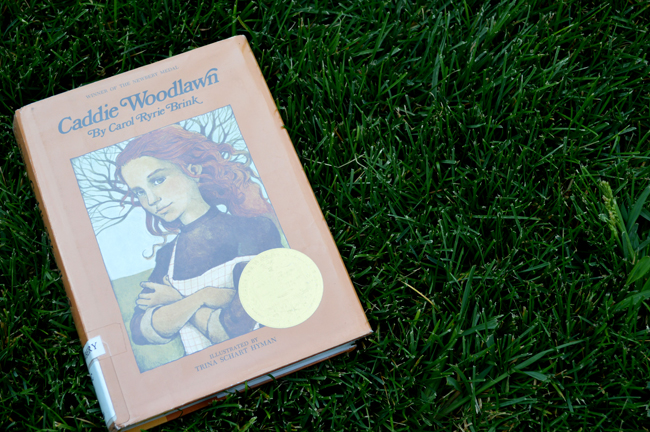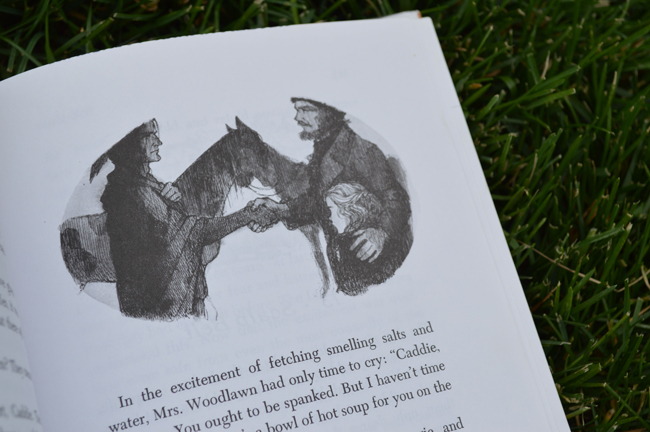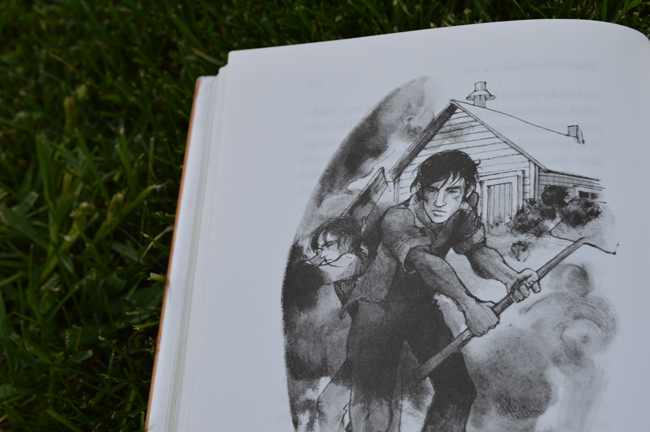I do not know how I grew up not reading this week’s Newbery. It was great! Caddie Woodlawn by Carol Ryrie Brink is based on the life of the author’s grandmother Caddie. Caddie is the middle daughter of a miller’s family growing up near Menomonie, Wisconsin in the 1890s, and Caddy is a fantastic tomboy always up for adventuring with her brothers Tom and Warren. I pass Menomonie every time I drive home to my parents. I loved reading the descriptions of spring and summer and fall that were so like and different from my own Wisconsin growing-up.
What I liked. I loved Caddie! She reminded me a lot of Laura Ingles Wilder, and I think that they would have been friends if they hadn’t been about 15 years and 25 miles apart. The story is really about Caddie growing up, and learning to embrace both her wild side and growing more kind and doing more “womanly” work.
What was interesting. I thought the strangest part of the book was this odd story that Caddie’s older brother Tom told about a farmer who kept lying to his neighbors about his lucky breaks, eventually leading to the man’s wife and all the surrounding wives being killed. It really did seem like the sort of story that a 13 year old boy would come up with, morbid and like a fairytale, and just a little odd. Caddie Woodlawn is of course both based on the stories the author heard from her grandmother but then also based on the author’s imagination in terms of how she put them together. But I am sure that that story really was almost exactly how a 13 year old would make up a fairytale. It seemed very authentic.
What were some limitations. I am having a hard time coming up with limitations. I think that the year did seem very full, and that perhaps breaking up the stories into several books might have worked too. (There is a sequel that I haven’t read.) But that’s not really a limitation as much as I just wanted more! Caddie has good friends who are Native Americans whom she saves from a mob at one point, and the way that the characters refer to the natives seems appropriately authentic to the time since it’s set against Caddy’s respect for them, but there might be a good case for updating some of the narrative nomenclature since it’s still such a popular book.
Why I think it’s a Newbery. It’s a great coming of age story, and one with a really strong woman. I do not understand how none of the Laura Ingles Wilder books ever won the Newbery (many received Newbery Honors), but this is the sort of book that I was hoping that I would get a chance to read by reading through the Newberies.
Similarity to other Newbery winners. In some ways, Caddie reminds me of Invincible Louisa, although that was a biography of a whole life about 50 years before. Really, Caddie belongs on my list of my favorite 19th century children’s stories along with girls like Calpernia Tate and Anna & Sarah (Plain and Tall), and May B, and of course Laura Ingles.
What it teaches me as a writer. I really thought that a lot of the chapters of Caddie had a nice building of drama. Caddie rushes into the dining room late, sees the minister, and drops a skirt full of nuts all over the floor, for example. In another episode, there is a ride to warn the Indian tribe, or there is the tension about whether the family is going to move back to England. Each chapter had its own arc of tension building moments up to a finish that was comic or poignant or somehow a satisfying place to finish.
Have you read Caddie Woodlawn? What are your favorite pioneer stories?
*Note* This post contains Amazon affiliate links, which means if you were to buy a book, I’d get a tiny commission at no cost to you. Thanks for supporting Stories & Thyme!*









I don’t know how I managed not to like this book as a kid. It’s a pioneer story! Think I need to give it a second shot…
You do! It’s about a pioneer names Caroline! I’m sure slogging through the previous newberies made this one seem even better to me. So perhaps read something boring beforehand to get the full effect!